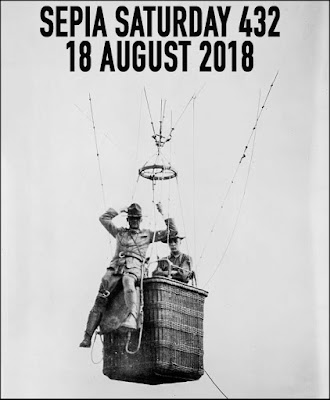Music can send you up
or bring you down.
Rock you to sleep
or set your feet in motion.
or bring you down.
Rock you to sleep
or set your feet in motion.
Romantic Nocturnes for moonlit nights,
or sprightly songs for sunny days,
there is always a tune
for any sentiment.
or sprightly songs for sunny days,
there is always a tune
for any sentiment.
Herzlichen Glückwunsch
zum Geburtstag!
~
zum Geburtstag!
~
Hearty Congratulations
on your Birthday!
on your Birthday!
This postcard of a musical airship was sent from Rostock, Germany on the 22nd of July, 1910 to Walter Hasselfeldt. Rostock is a port city in the north German state Mecklenburg-Vorpommern, situated at the mouth of the Warnow river on the Baltic Sea coast.
Though the postcard artist took some imaginative license to suspend a small orchestra in a gondola beneath an airship, his design was actually very close to the real design of the LZ4, an experimental airship constructed under the direction of Ferdinand von Zeppelin (1838-1917). Count von Zeppelin was a scion of a noble family that came from Zepelin, a municipality of Rostock where this postcard was mailed.,
 |
| Zeppelin LZ4, preparing for departure on 04 August 1908 Source: www.airships.net |
During it next major test flight on 4 August 1908, the LZ4 was tragically destroyed in a fire when it came down for emergency engine repairs at Echterdingen, south of Stuttgart. The airship was docked, but the mooring tethers broke due to strong winds. It crashed into some trees and a static spark ignited the hydrogen. An estimated 40 to 50 thousand spectators witnessed the accident, but the public was so enthralled by the wonder of lighter-than-air flight that within 24 hours of the crash, Zepplin had received enough money in unsolicited donation to rebuild a new airship.
 |
| wreckage of Zeppelin LZ4, near Echterdingen, Germany 05 August 1908. Source: www.airships.net |
This is my contribution to Sepia Saturday
click the link for more flights of fancy.
click the link for more flights of fancy.






5 comments:
Once again you're right on the mark with a musical version of the prompt! Well done!! And fun! As always!! :) But those first dirigibles weren't always the safest! (gulp!)
At least a hot air balloon is just heating air and rising with it...where a gas balloon has constant lift, but there were the dangers too. I do think it was at least steerable, which hot air balloons don't seem to be.
Leave it to you to find an orchestra suspended in a balloon basket! Although that is not so far-fetched with today's hot air balloons. Maybe not an entire orchestra, but a small musical group could certainly play aloft if they were so inclined.
Well done matching the prompt!
I would like to think they might have played Fly Me To The Moon ........
Post a Comment